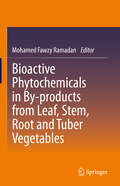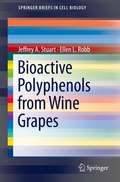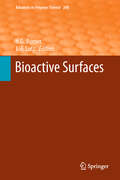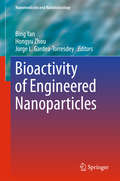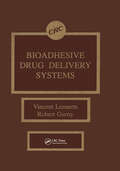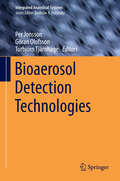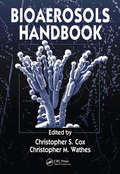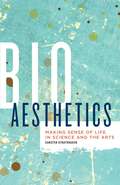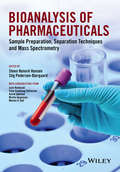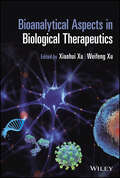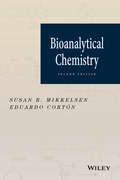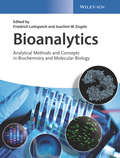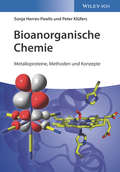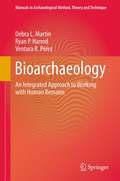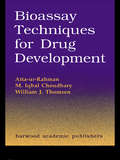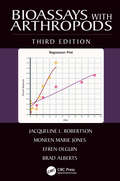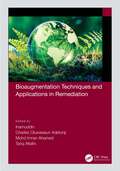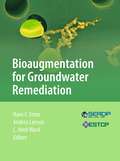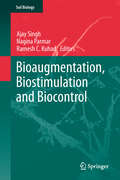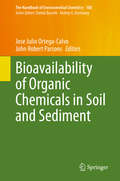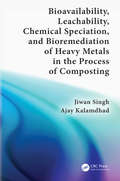- Table View
- List View
Bioactive Phytochemicals in By-products from Leaf, Stem, Root and Tuber Vegetables
by Mohamed Fawzy RamadanThis book offers a comprehensive overview of bioactive phytochemicals within by-products from leaf, stem, root, and tuber vegetables, and it explores the valorisation of these vegetable cultivation and processing by-products, not only as a source of valuable bioenergy but also for health purposes. Divided into 16 chapters, the book begins with an introduction to the economic significance of biowaste generated from vegetable cultivation and processing, setting the stage for subsequent chapters that cover the phytochemical, nutritional, biochemical and physicochemical properties of vegetable processing wastes and their multifaceted applications. Readers will find valuable insights into the valorisation of process by-products from diverse vegetables like cabbage, spinach, watercress, asparagus, celery, kohlrabi, beetroot, carrot, celeriac, turnip, sweet potato, potato and taro. In each chapter, readers will find an economic perspective for each biowaste, the chemical analysis of the bioactive compounds, their biological and functional properties, and relevant food and non-food applications of extracts and bioactive compounds from vegetable by-products. This book, coupled with its companion volume, " Bioactive Phytochemicals in By-products from Bulb, Flower and Fruit Vegetables" serves as an indispensable tool for students, scholars, and researchers seeking to expand their knowledge within this field in agricultural and nutritional sciences. It also extends its relevance to professionals within the food industry, offering the latest insights and findings from cutting-edge research.
Bioactive Polyphenols from Wine Grapes (SpringerBriefs in Cell Biology)
by Ellen L Robb Jeffrey A StuartIs red wine good for you? And if so, why? How much? And what are the actual benefits? This addition to the SpringerBriefs in Cell Biology series thoroughly but succinctly answers these questions. It covers the biochemistry, health benefits and therapeutic potential of wine grapes. It begins with an overview of phytoalexin production in Vitis vinifera (Common Grape Vine), detailing the relationship of resveratrol to analogues such as pterostilbene, piceid and the viniferins (resveratrol oligomers). The discussion then turns to the hundreds of reports linking resveratrol and related grape vine polyphenols to various beneficial health effects especially cardio- and cerebro- vascular, metabolic, anti-inflammatory and more. Also addressed are the numerous intracellular mechanisms that have been shown to mediate the effects of these compounds in mammalian cells and tissues. Finally, the authors discuss aspects of polyphenol bioavailability and how this will influence choices taken for delivering these compounds as nutritional supplements. A brief chapter containing general conclusions and prospectus rounds out the information.
Bioactive Surfaces (Advances in Polymer Science #240)
by Jean-Francois Lutz Hans G. BörnerErik Wischerhoff, Nezha Badi, André Laschewsky and Jean-François Lutz Smart Polymer Surfaces: Concepts and Applications in Biosciences; S. Petersen, M. Gattermayer and M. Biesalski Hold on at the Right Spot: Bioactive Surfaces for the Design of Live-Cell Micropatterns; Julien Polleux Interfacing Cell Surface Receptors to Hybrid Nanopatterned Surfaces: A Molecular Approach for Dissecting the Adhesion Machinery; Abigail Pulsipher and Muhammad N. Yousaf Self-Assembled Monolayers as Dynamic Model Substrates for Cell Biology; D. Volodkin, A. Skirtach and H. Möhwald LbL Films as Reservoirs for Bioactive Molecules; R. Gentsch and H. G. Börner Designing Three-Dimensional Materials at the Interface to Biology; Joerg C. Tiller Antimicrobial Surfaces;
Bioactivity of Engineered Nanoparticles (Nanomedicine and Nanotoxicology)
by Bing Yan Hongyu Zhou Jorge L. Gardea-TorresdeyThis book brings together reviews from international experts who are exploring the biological activities of nanomaterials for medical applications or to better understand nanotoxicity. Topics include but are not limited to the following: 1) mechanistic understanding of nanostructure-bioactivity relationships; 2) the regulation of nanoparticles' bioactivity by means of chemical modification; 3) the new methodologies and standard methods used to assess nanoparticles' bioactivity; 4) the mechanisms involved in nanoparticle-biomolecule interactions and nanoparticle-cell interactions; and 5) biomedical applications of nanotechnology. The book will be a valuable resource for a broad readership in various subfields of chemical science, engineering, biology, environment, and medicine.
Bioadhesive Drug Delivery Systems
by Vincent M. Lenaerts Robert GurnyThis comprehensively written text covers, in-depth, all aspects of bioadhesive systems. Bioadhesive systems are presently playing a major role in the field because of their ability to maintain a dosage form at a precise body-site for a prolonged period of time over which the active principle is progressively released. Included in this book are descriptions of the different mucosae in healthy and pathological situations, a theoretical approach of polymers-mucin interactions, and a comparative description of the methods used to evaluate bioadhesion. Up-to-date reviews of pharmaceutical applications are also given - subdivided according to the route of administration and type of system. It also contains a chapter devoted to the fundamentals of bioadhesion. This reference is an indispensable guide for researchers in the pharmaceutical field as well as academic researchers.
Bioaerosol Characterisation, Transportation and Transmission: Fundamental, Modelling and Application
by Jiyuan Tu Yihuan YanThis book aims to predict and model the transport of bioaerosols, identify their transmission characteristics, and assess occupants’ infection risks. Although existing epidemiological books provide fundamental infection rate of existing diseases, the ability of predicting emerging disease transmission in the air and assessing occupants’ infection risks to the bioaerosols is significantly lacking. This book is considered as a professional book that provides in-depth discussion of the aforementioned issues and provides potential approaches to solve these issues would be highly demanded by readers in this emerging research field. This book offers essential and systematic analysis on the fate of bioaerosols from their release in the air to the final destination in human’s respiratory systems through direct 3D visualizations techniques. It also provides quantifiable method to assess each occupant’s infection risks to the infectious bioaerosols in indoor environments. The readers will gain essential fundamental characteristics of bioaerosols (active time, viability, etc.) and will gain the advanced skills on how to integrate these properties into numerical modeling and assess the occupants’ exposure risks.
Bioaerosol Detection Technologies (Integrated Analytical Systems)
by Per Jonsson Göran Olofsson Torbjörn TjärnhageThis book is intended to give technological background and practical examples, but also to give general insight into the on-going technology development in the area of biodetection. The content is therefore suitable for an array of stakeholders (decision makers, purchasing officers, etc. ) and end-users of biodetection equipment within the areas of health, environment, safety and security, and military preparation. The book is divided into three sections. The first section discusses the fundamental physical and biological properties of bioaerosol's. The second section goes into more detail and discusses in-depth the most commonly used detection principles. The third section of the book is devoted to technologies that have been used in standoff applications. The last section of the book gives an overview of trends in bioaerosol detection. The reader of this book will gain knowledge about the different biodetection technologies and thus better judge their capabilities in relation to desired applications.
Bioaerosols Handbook
by Christopher S. Cox; Christopher M. WathesThis comprehensive handbook provides up-to-date knowledge and practical advice from established authorities in aerosol science. It covers the principles and practices of bioaerosol sampling, descriptions and comparisons of bioaerosol samplers, calibration methods, and assay techniques, with an emphasis on practicalities, such as which sampler to use and where it should be placed. The text also offers critiques concerning handling the samples to provide representative and meaningful assays for their viability, infectivity, and allergenicity. A wide range of microbes-viz., viruses, bacteria, fungi and pollens, and their fragments-are considered from such perspectives.Bioaerosols Handbook is divided into four parts, providing a wide-ranging reference work, as well as a practical guide on how best to sample and assay bioaerosols using current technology.
Bioaesthetics: Making Sense of Life in Science and the Arts (Posthumanities #43)
by Carsten StrathausenIn recent years, bioaesthetics has used the latest discoveries in evolutionary studies and neuroscience to provide new ways of looking at art and aesthetics. Carsten Strathausen&’s remarkable exploration of this emerging field is the first comprehensive account of its ideas, as well as a timely critique of its limitations. Strathausen familiarizes readers with the basics of bioaesthetics, grounding them in its philosophical underpinnings while articulating its key components. Importantly, he delves into the longstanding problem of the &“two cultures&” that separate the arts and the sciences. Seeking to make bioaesthetics a more robust way of thinking, Strathausen then critiques it for failing to account for science&’s historical and cultural assumptions. At its worst, he says, biologism reduces artworks to mere automatons that rubber-stamp pre-established scientific truths. Written with a sensitive understanding of science&’s strengths, and willing to refute its best arguments, Bioaesthetics helps readers separate the sensible from the specious. At a time when humanities departments are shrinking—and when STEM education is on the rise—Bioaesthetics makes vital points about the limitations of science, while lodging a robust defense of the importance of the humanities.
Bioanalysis of Pharmaceuticals
by Stig Pedersen-Bjergaard Steen Honoré Hansenharmaceuticals: Sample Preparation, Separation Techniques and Mass Spectrometry: Is an introductory student textbook discussing the different principles and concepts clearly and comprehensively, with many relevant and educational examples Focuses on substances that are administered as human drugs, including low-molecular drug substances, peptides, and proteins Presents both the basic principles that are regularly taught in universities, along with the practical use of bioanalysis as carried out by researchers in the pharmaceutical industry and in hospital laboratories Is aimed at undergraduate students, scientists, technicians and researchers in industry working in the areas of pharmaceutical analyses, biopharmaceutical analyses, biological and life sciences.The book includes multiple examples to illustrate the theory and application, with many practical aspects including calculations, thus helping the student to learn how to convert the data recorded by instruments into the real concentration of the drug substances within the biological sample.
Bioanalytical Aspects in Biological Therapeutics
by Weifeng Xu Xiaohui XuBioanalytical Aspects in Biological Therapeutics Deepen your understanding of how critical data are generated from bioanalysis In Bioanalytical Aspects in Biological Therapeutics, a team of renowned chemists, immunologists, and biologists delivers a timely and practical exploration of the diverse scientific and technical literature on the bioanalytical investigation of current biotherapeutics under development. The book discusses the challenges and considerations for bioanalytical support, covering a wide range of central topics in the field, including overview and basic immunology for testing of biological therapeutics, pharmacokinetic aspects, clinical immunogenicity prediction and testing, biomarker testing, biotransformation assessment for biologics, statistical aspects of bioanalytical testing, regulatory expectations, and more. Drug development and analysis professionals will learn how critical data are generated from bioanalysis and how proven tools and methods are applied to the development of biologics. Alongside coverage of topics like PK, immunogenicity, neutralizing antibody assays, and the importance of quality control for reagents, readers will benefit from: A thorough overview of the development of biotherapeutics and the role played by bioanalytical tests, as well as basic immunology for bioanalytical testing of biological therapeutics Comprehensive explorations of platform and instrument considerations in bioanalytical testing, pharmacokinetics assays, and biomarker analysis using LC-MS, LBA, and other technologies Practical discussions of immunogenicity prediction, preclinical and clinical anti-drug antibody assays, and bioanalytical schemes for anti-drug neutralizing antibody assays In-depth examinations of critical reagents in bioanalysis Regulatory expectations for bioanalytical method development, validation, and sample testing Perfect for pharmaceutical scientists in industry, Bioanalytical Aspects in Biological Therapeutics will also earn a place in the libraries of pharmaceutical regulators and other professionals working in pharmaceutical companies, as well as graduate students studying bioanalytical assays for biological therapeutics.
Bioanalytical Chemistry
by Susan R. Mikkelsen Eduardo CortónA timely, accessible survey of the multidisciplinary field of bioanalytical chemistry Provides an all in one approach for both beginners and experts, from a broad range of backgrounds, covering introductions, theory, advanced concepts and diverse applications for each method Each chapter progresses from basic concepts to applications involving real samples Includes three new chapters on Biomimetic Materials, Lab-on-Chip, and Analytical Methods Contains end-of-chapter problems and an appendix with selected answers
Bioanalytics: Analytical Methods and Concepts in Biochemistry and Molecular Biology
by Friedrich Lottspeich Joachim W. EngelsAnalytical methods are the essential enabling tools of the modern biosciences. This book presents a comprehensive introduction into these analytical methods, including their physical and chemical backgrounds, as well as a discussion of the strengths and weakness of each method. It covers all major techniques for the determination and experimental analysis of biological macromolecules, including proteins, carbohydrates, lipids and nucleic acids. The presentation includes frequent cross-references in order to highlight the many connections between different techniques. The book provides a bird´s eye view of the entire subject and enables the reader to select the most appropriate method for any given bioanalytical challenge. This makes the book a handy resource for students and researchers in setting up and evaluating experimental research. The depth of the analysis and the comprehensive nature of the coverage mean that there is also a great deal of new material, even for experienced experimentalists. The following techniques are covered in detail: - Purification and determination of proteins - Measuring enzymatic activity - Microcalorimetry - Immunoassays, affinity chromatography and other immunological methods - Cross-linking, cleavage, and chemical modification of proteins - Light microscopy, electron microscopy and atomic force microscopy - Chromatographic and electrophoretic techniques - Protein sequence and composition analysis - Mass spectrometry methods - Measuring protein-protein interactions - Biosensors - NMR and EPR of biomolecules - Electron microscopy and X-ray structure analysis - Carbohydrate and lipid analysis - Analysis of posttranslational modifications - Isolation and determination of nucleic acids - DNA hybridization techniques - Polymerase chain reaction techniques - DNA sequence and epigenetic modification analysis - Analysis of protein-nucleic acid interactions - Analysis of sequence data - Proteomics, metabolomics, peptidomics and toponomics - Chemical biology
Bioanorganische Chemie: Metalloproteine, Methoden und Modelle
by Peter Klüfers Sonja Herres-PawlisMit dieser Einfuhrung in die faszinierende Welt der Metalloproteine lernen Chemiker, Biochemiker und Biotechnologen Mechanismen, Methoden und Modellvorstellungen der bioanorganischen Chemie kennen. In einer Synthese aus aktuellen Arbeiten an Metalloenzymzentren und den Grundlagen der Koordinationschemie fuhren die Autoren in dieses spannende und im Wortsinne komplexe Thema ein. Der erste Teil des Buches stellt anhand ausgewahlter Metalloproteine dar, dass die Natur die koordinationschemischen Prinzipien "kennt" und in einer Weise nutzt, die vorbildhaft fur die Entwicklung synthetischer Katalysatoren sein kann. Einige der verwendeten Konzepte werden in Einschuben naher beleuchtet. Der zweite Teil vermittelt die Grundlagen der verschiedenen instrumentellen Methoden fur die Untersuchung von Metalloproteinen, von der Kristallographie uber die Vielfalt an spektroskopischen Methoden (UV, Raman, Fluoreszenz, EPR, Mo?bauer etc.) bis hin zu elektrochemischen und computerchemischen Methoden. Durch die Betonung der koordinationschemischen Grundlagen biochemischer Funktion ist dieses Lehrbuch eine wichtige Erganzung zu den Standardlehrbuchern der Biochemie und der anorganischen Chemie. Der modulare Aufbau erleichtert dabei den Einsatz fur unterschiedliche Lehrveranstaltungen und Studiengange.
Bioarchaeological and Forensic Perspectives on Violence
by Debra L. Martin Cheryl P. AndersonEvery year, there are over 1. 6 million violent deaths worldwide, making violence one of the leading public health issues of our time. And with the 20th century just behind us, it's hard to forget that 191 million people lost their lives directly or indirectly through conflict. This collection of engaging case studies on violence and violent deaths reveals how violence is reconstructed from skeletal and contextual information. By sharing the complex methodologies for gleaning scientific data from human remains and the context they are found in, and complementary perspectives for examining violence from both past and contemporary societies, bioarchaeology and forensic anthropology prove to be fundamentally inseparable. This book provides a model for training forensic anthropologists and bioarchaeologists, not just in the fundamentals of excavation and skeletal analysis, but in all subfields of anthropology, to broaden their theoretical and practical approach to dealing with everyday violence.
Bioarchaeology
by Clark Spencer LarsenThese important essays address the biological consequences of the arrival of Europeans in the New World and on the lifeways of native populations following contact in the late 16th century. Moving away from monocausal explanations of population change, they maintain that disease should be viewed as only a facet of a complex problem and that issues relating to diet, nutrition, activity, the work environment, and social and political change are equally important.
Bioarchaeology of Impairment and Disability: Theoretical, Ethnohistorical, and Methodological Perspectives (Bioarchaeology and Social Theory)
by Jennifer F. Byrnes Jennifer L. MullerOver the years, impairment has been discussed in bioarchaeology, with some scholars providing carefully contextualized explanations for their causes and consequences. Such investigations typically take a case study approach and focus on the functional aspects of impairments. However, these interpretations are disconnected from disability theory discourse. Other social sciences and the humanities have far surpassed most of anthropology (with the exception of medical anthropology) in their integration of social theories of disability. This volume has three goals: The first goal of this edited volume is to present theoretical and methodological discussions on impairment and disability. The second goal of this volume is to emphasize the necessity of interdisciplinarity in discussions of impairment and disability within bioarchaeology. The third goal of the volume is to present various methodological approaches to quantifying impairment in skeletonized and mummified remains.
Bioarchaeology: An Integrated Approach to Working with Human Remains (Manuals in Archaeological Method, Theory and Technique #6)
by Ventura R. Pérez Debra L. Martin Ryan P. HarrodBioarchaeology is the analysis of human remains within an interpretative framework, including a wide range of contextual information. This comprehensive and much-needed manual provides both a starting point and a reference for archaeologists working in this integrative field. The authors cover a range of bioarchaeological methods and theory including: · Ethical issues involved in dealing with human remains, specifically related to NAGPRA · Field and taphonomic clues · Lab and Forensic techniques · Best practices methods for Excavation techniques · Special applications of Bioarchaeology · Theoretical frameworks of Bioarchaeology With case studies from over twenty years each of bioarchaeological research, the authors integrate theoretical and methodological discussion with a wide range of field studies, from different geographic areas, time periods, and data types, to demonstrate the full scope of this important field of study.
Bioassay Techniques for Drug Development
by Atta-ur-Rahman M. Iqbal Choudhary William J. ThomsenThe goal of an activity-directed isolation process is to isolate bioactive compounds which may provide structural leads of therapeutic importance. Whereas the traditional process of drug development is long and expensive, simple and rapid bioassays can serve as the starting point for drug discovery. This book presents a range of "bench top" bioassa
Bioassays with Arthropods
by Efren Olguin Brad Alberts Jacqueline Robertson Moneen JonesImagine a statistics book for bioassays written by a statistician. Next, imagine a statistics book for bioassays written for a layman. Bioassays with Arthropods, Third Edition offers the best of both worlds by translating the terse, precise language of the statistician into language used by the laboratory scientist. The book explains the statistical basis and analysis for each kind of quantal response bioassay in just the right amount of detail. The first two editions were a great reference for designing, conducting, and interpreting bioassays: this completely revised and updated third edition will also train the laboratory scientist to be an expert in estimation of dose response curves. New in the Third Edition: Introduces four new Windows and Apple-based computer programs (PoloJR, OptiDose, PoloMixture and PoloMulti) for the analyses of binary and multiple response analyses, respectively Replaces out-of-date GLIM examples with R program samples Includes a new chapter, Population Toxicology, and takes a systems approach to bioassays Expands the coverage of invasive species and quarantine statistics Building on the foundation set by the much-cited first two editions, the authors clearly delineate applications and ideas that are exceptionally challenging for those not already familiar with their use. They lead you through the methods with such ease and organization, that you suddenly find yourself readily able to apply concepts that you never thought you would understand. To order the PoloSuite computer software described in Bioassays with Arthropods, Third Edition, use the order form found at www.leora-software.com or contact the LeOra Software Company at leorasoftware@gmail.com.
Bioaugmentation Techniques and Applications in Remediation
by InamuddinIt has been observed that rapid population expansion has raised the amount of anthropogenic activity, resulting in high levels of pollution in water, air, and solid waste as well as an increase in the pressure placed on agricultural lands. Bioaugmentation Techniques and Applications in Remediation provides detailed information on bioaugmentation approaches for the remediation of sediments, water, and soil polluted with organic and inorganic pollutants. Practical applications of bioaugmentation techniques performed in restricted systems under controlled conditions, laboratory investigations, and in the field are addressed. Special emphasis is placed on the applications of nanomaterials in combination with bioaugmentation techniques for enhanced bioremediation efficiency. FEATURES Explores abiotic and biotic factors that enhance and facilitate environmental remediation of contaminants Provides a primer on the elementary microbial processes entailed in bioaugmentation Summarizes methods and approaches for executing bioaugmentation technology Details commercially available products and instrumentation This book is an ideal resource for researchers, students, and engineers working in materials science and bioremediation.
Bioaugmentation for Groundwater Remediation (SERDP ESTCP Environmental Remediation Technology #5)
by C. Herb Ward Hans F. Stroo Andrea LeesonThis volume provides a review of the past 10 to 15 years of intensive research, development and demonstrations that have been on the forefront of developing bioaugmentation into a viable remedial technology. This volume provides both a primer on the basic microbial processes involved in bioaugmentation, as well as a thorough summary of the methodology for implementing the technology. This reference volume will serve as a valuable resource for environmental remediation professionals who seek to understand, evaluate, and implement bioaugmentation.
Bioaugmentation, Biostimulation and Biocontrol (Soil Biology #10)
by Ajay Singh Ramesh C. Kuhad Nagina ParmarBioaugmentation, biostimulation and biocontrol approaches using microbial inoculants, biofertilizers, biochemicals and organic amendments improve soil biology, fertility and crop productivity by providing plant growth-promoting nutrients and suppressing soil-borne diseases and plant-parasitic nematodes. Our knowledge of microbial diversity and its function in soils has been increased tremendously due to the availability of a wealth of data gained through recent advances in the development of molecular methods and metagenomics for the evaluation of microbial diversity and functions in the rhizosphere environment of soil. Chapters dealing with the application of biofertilizers and organic amendments are contributed by experts - authorities in the area of soil science including microbiology and molecular biology - from academic institutions and the industry.
Bioavailability of Organic Chemicals in Soil and Sediment (The Handbook of Environmental Chemistry #100)
by Jose Julio Ortega-Calvo John Robert ParsonsThis book discusses bioavailability concepts and methods, summarizing the current knowledge on bioavailability science, as well as possible pathways for integrating bioavailability into risk assessment and the regulation of organic chemicals. Divided into 5 parts, it begins with an overview of chemical distribution in soil and sediment, as well as the bioavailability and bioaccumulation of chemicals in plants, soil, invertebrates and vertebrates (including humans). It then focuses on the impact of sorption processes and reviews bioavailability measurement methods. The closing chapters discuss the impact of bioavailability studies on chemical risk assessment, and highlights further research needs. Written by a multi-disciplinary team of authors, it is an essential resource for scientists in academia and industry, students, as well as for authorities.
Bioavailability, Leachability, Chemical Speciation, and Bioremediation of Heavy Metals in the Process of Composting
by Jiwan Singh Ajay KalamdhadCurrently, it is a serious concern to manage waste in the environment. Therefore, detailed knowledge of heavy metals, their eco-toxicological and health effects and ecofriendly approaches for their immobilization and detoxification is urgently required to control and minimize the environmental pollution. Composting is one of the popular methods in waste management and there are a lot of issues pertaining to composting. One of it is the leaching of heavy metals. This book discusses thoroughly, the availability, leachability and the speciation of heavy metals in the entire process of composting.
